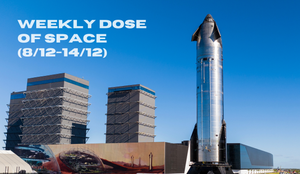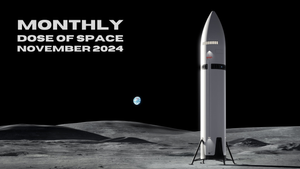
Weekly Dose of Space (15/9-21/9)
Welcome back to Weekly Dose of Space! This week had seven orbital launches occur, with most happening on the 20th. News this week had India approve several major space projects and SpaceX possibly moving to sue the U.S. Federal Aviation Administration. As always, we'll also look ahead to what the worldwide launch schedule might look like next week.
SpaceX
This week at Starbase began on September 17th when teams were spotted removing hardware from Starhopper, mainly the outer sheet metal layer. It's unknown what teams are doing to Starhopper or what the future of the old test vehicle is. The first launch towers 'chopsticks' were spotted performing movement tests on the 17th.
Ship 31 fired up its engines on the 18th for its six-engine static fire at the Massey's test site. Ship 31 is currently expected to fly on the sixth flight of Starship-Super Heavy.

Removal of hardware from Starhopper continued through the 18th with its mast being removed from it on the 19th, the mast was used to hold weather monitoring equipment.
Early in the morning of the 20th, Ship 31 rolled back from the Massey's test site to the production site. While Ship 31 was heading back to the production site, Booster 12 and its hot-staging ring left for the launch site. After sunrise, Booster 12 was lifted as high as the towers 'chopsticks' can travel before being placed onto the orbital launch mount.
Following the lift of Booster 12, Ship 30 was also rolled out to the launch site. While Ship 30 was waiting to be lifted in the early hours of the 21st, Booster 12's hot-staging ring was installed ontop of the booster. Ship 30 was then lifted atop of Booster 12 during the day.
Launches This Week
September 17th - Angara 1.2 with Kosmos 2577 & 2578
An Angara 1.2 lifted off from the Plesetsk Cosmodrome carrying two unknown military satellites into sun-synchronous orbit for the Russian government.
September 17th - Falcon 9 with Galileo L13
A Falcon 9 lifted off from Space Launch Complex 40, in Florida, carrying two Galileo satellites into medium Earth orbit for Europe. The booster for this mission was B1067 flying for the twenty-second time and landing downrange on the drone ship 'Just Read The Instructions' after the most daring re-entry of a Falcon 9 booster so far. Details about this mission and booster landing are available here.

September 19th - Long March 3B/E with BeiDou 59 & 60
A Long March 3B/E blasted off from Launch Complex 2 at the Xichang Satellite Launch Center carrying two third-generation BeiDou navigation satellites. These satellites were deployed into a medium Earth orbit thanks to the use of a Yuanzheng-1 upper-stage, allowing the spacecraft to reserve onboard propellant for their ten-year operational lives.

September 20th - Long March 2D with six Jilin-1 satellites
Six Jilin-1 satellites, as part of the Kuanfu-02B group, were delivered to a sun-synchronus orbit by a Long March 2D flying from the Taiyuan Satellite Launch Center. These satellites are believed to be remote-sensing spacecraft offering imaging resolutions between 0.5 and 4 meters to customers.

September 20th - Kuaizhou-1A with four Tianqi satellites
Another launch from the Xichang Satellite Launch Center occurred on the 20th with a Kuaizhou-1A lifting off to low Earth orbit. Onboard this launch was four Tianqi Internet-of-Things spacecraft as part of a thirty-eight satellite constellation, with thirty-two spacecraft already in orbit.

September 20th - Falcon 9 with Starlink Group 9-17
SpaceX launched another Falcon 9 carrying twenty Starlink satellites into low Earth orbit from Space Launch Complex 4E, in California. The booster for this mission was B1075 making its thirteenth flight and landing on the drone ship 'Of Course I Still Love You' downrange.
Liftoff! pic.twitter.com/u4pefHLdda
— SpaceX (@SpaceX) September 20, 2024
Falcon 9 lifting off from Space Launch Complex 4E for the Starlink Group 9-17 mission, via SpaceX on X.
September 20th - Electron for 'Kinéis Killed the RadIoT Star'
Rocket Lab's Electron rocket launched its second batch of Kinéis Internet of Things satellites from Launch Complex 1A on the Māhia Peninsula, in New Zealand, to low Earth orbit. Five satellites were onboard Electron for the 'Kinéis Killed the RadIoT Star' mission.

SpaceX moving to sue the FAA

In a post on X, formerly Twitter, SpaceX announced it's complaints about the U.S. Federal Aviation Administration on September 19th, a few days after the company's Chief Executive Officer, Elon Musk, suggested the company would sue the federal agency. In the post, SpaceX said the following in regard to the company's reasoning:
"For nearly two years, SpaceX has voiced its concerns with the FAA’s inability to keep pace with the commercial spaceflight industry. It is clear that the Agency lacks the resources to timely review licensing materials, but also focuses its limited resources on areas unrelated to public safety."
"These distractions continue to directly threaten national priorities and undercut American industry's ability to innovate."
SpaceX's move to against the Federal Aviation Administration came two days after the agency proposed 633,009 United States Dollars in fines for failing to follow its license requirements during two launches in 2023. These violations are conducting a launch from a new control room without the T-2 hour readiness poll on June 18th 2023 and the use of an unapproved rocket propellant on July 28th 2023. When proposing these fines, the agency stated:
“Safety drives everything we do at the FAA, including a legal responsibility for the safety oversight of companies with commercial space transportation licenses,” – “Failure of a company to comply with the safety requirements will result in consequences.”
What SpaceX seeks to gain is largely unclear beyond a 'faster acting' Federal Aviation Administration for approving Falcon 9, Falcon Heavy, and Starship-Super Heavy operations. However for Elon Musk, SpaceX's Chief Executive Officer, this could be a political maneuver as part of the 2024 United States election.
Indian government approves multiple major space projects
On September 18th the Indian government approved plans for the Chandrayaan-4 lunar sample return mission, a Venus orbiter mission, the first module of the nation's space station, and a reusable launch vehicle. These projects have been allocated approximately 2.7 billion United States Dollars.
The government allocated the Chandrayaan-4 lunar sample return mission 21 billion rupees, approximately 253 million United States Dollars. This mission is set to launch on two LVM-3 launch vehicles no earlier than 2027.
For India's human spaceflight program, the government increased the budget of the Gaganyaan program to 201 billion rupees, approximately 432 million United States dollars. The first module of India's Bharatiya Antariksh Station was also approved. Four Gaganyaan missions are set to be completed by 2026, with technologies being demonstrated for the first station modules by the end of 2028.
To support the nation's space efforts in the next decade, the Next Generation Launch Vehicle's development was approved and allocated 82.4 billion rupees, approximately 994 million United States Dollars, for development. Three test flights are expected to occur over eight years. Once operational the vehicle is expected to lift up to 30,000 kilograms to low Earth orbit, between 8,500 and 24,000 kilograms to a geostationary transfer orbit, and between 7,000 to 22,500 kilograms to a trans-lunar trajectory.
A mission to Venus was also approved and allocated 20.56 billion rupees, approximately 248 million United States Dollars, for a launch no earlier than early 2028. This mission is expected to study the planet's geology, evolution, and atmosphere from orbit.
ULA to fly final Vulcan test mission in October
United Launch Alliance announced on September 17th that it is now targeting no earlier than October 4th, 2024, for the second certification mission of its Vulcan launch vehicle.
This launch was initially delayed a few months ago when the original payload, Sierra Space's Dream Chaser cargo spaceplane, would not be on track for a launch this year. Due to delays with Dream Chaser, United Launch Alliance is instead opting to fly an inert payload to complete the second and final certification mission of Vulcan, to allow it to launch sensitive U.S. military payloads.
During the mission, the Centaur V second-stage is also expected to conduct technology demonstrations for future improvements of the stage, like being able to last month in orbit between burns.
For this mission the vehicle will fly in the VC2S configuration; that is a Vulcan first-stage booster, a Centaur V second-stage, two GEM 63XL solid rocket boosters, and the 15.5-meter long 5.4-meter diameter fairing. Had Dream Chaser been on schedule Vulcan would have flown in the VC4L configuration, with four GEM 63XL solid rocket boosters, and the 21.3-meter long 5.4-meter diameter fairing.
What to Expect Next Week
Starbase
As we have been reporting for the last few weeks, the fifth test flight of SpaceX's Starship-Super Heavy vehicle is still awaiting regulatory approval from the U.S. Federal Aviation Administration. This latest flight test requires a change in the flight plan, notably a potential landing of Booster 12 back at the launch site on the launch towers 'chopsticks'. The Federal Aviation Administration is currently not expected to approve this launch until November due to environmental concerns and SpaceX's late submission of information.
Both vehicles for flight five, Booster 12 and Ship 30, are ready for flight pending a possible wet dress rehearsal.
September 24th - Jielong-3 with a to-be-announced payloads
A Jielong-3 rocket is believed to be targeting launch on September 24th from a sea launch platform in the Yellow Sea. The payloads for this launch remain to be announced.
September 24th - Kinetica-1 with to-be-announced payloads
A Kinetica-1 launch vehicle is believed to also be targeting launch on September 24th from the Jiuquan Satellite Launch Center. The payloads for this launch also remain to be announced.
September 25th - Falcon 9 with Starlink Group 9-8
Another batch of Starlink satellites are expected to be launched from Space Launch Complex 4E atop of a Falcon 9. The booster for this mission is currently unknown.
September 26th - Falcon 9 with Crew-9
SpaceX is expected to launch Crew-9 atop of Falcon 9 carrying Nick Hague and Aleksandr Gorbunov to the International Space Station. The booster supporting this mission will be B1085, flying for the second time and landing back at Landing Zone 1.




